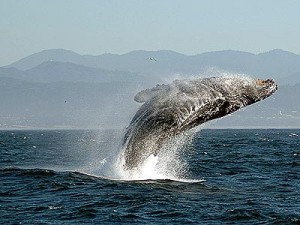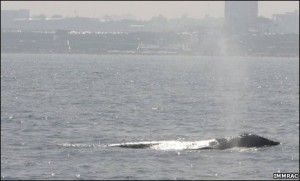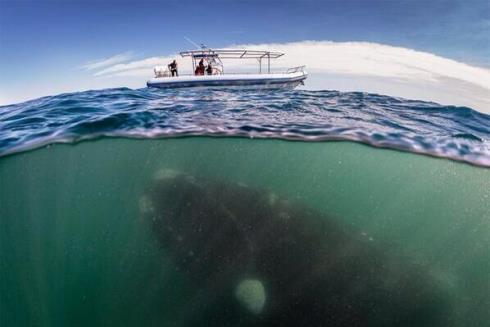The Grey Whale is not one of the larger whales, but adults can reach 55ft. It has no dorsal fin, but is distinguished by a series of low bumps on the back near the tail. It has a smallish head (in proportion to the body), with two or three shallow grooves on the throat, and two blow-holes. The baleen, the means by which whales filter small crustaceans from mud and water, is hair-like, short and thick, with coarse, frayed inner edges. Sometimes the snout is seen covered in mud, or with barnacles adhering to it. These appear to irritate it, and may be a reason they seek out brackish, shore water to dislodge them. The body streamlining is also affected.
This whale is probably best known today for the extraordinary annual migration between the Arctic feeding grounds, and the breeding and calf-rearing grounds off the coast of Baja California. Grey whales undertake the longest migration of any known mammal, and researchers have suggested that these epic journeys could also be driven by the threat of predation from killer whales.
Its habit of venturing within sight of land to breed almost caused its extinction. In the days of intensive whaling, in the 1870’s, something remarkable was noticed. The whales had changed their migration habits and were avoiding the coastal areas. By what means could whales who experienced the dangers posed by whalers near the coasts communicate this to others within the population? At the same time, they were known as ‘devil-fish’ among whalers, and had a reputation for fierceness and aggression, attacking boats with little provocation. They swim faster than the similarly sized sperm whale, and once harpooned, would charge frantically about, capsizing boats and drowning men..
The best explanation seems to take note of the mother/calf bond, strong in all whales, but particularly so with Grey Whales. One particularly vile advantage of this was taken in the whaling days, when they used to harpoon a calf, preferably without killing it, and tow it toward the shore, the whalers knowing full well the mother would follow, and could be killed without trouble in shallower waters. For all the depredations of killer whales (Orcinus orca), man was the real enemy.
Yet, accounts such as this suggest a different conclusion. Science writer Jane E. Brody observed a large group of California grey whales in their winter home, at San Ignacio Lagoon. She tells of one “as long as a city bus and weighing about 35 tons, and her two-ton calf , bearing down hard on our 16-foot [5-m] skiff.” Then, “just when a collision seemed inevitable, the mother whale submerged and eased herself under the idling boat, lifting it partly out of the water with her blows and pushing it about with her heavily barnacled back,” relates Brody. “The calf swam alongside and presented its dimpled head to be stroked by the two-legged mammals it dwarfed.” She continues: “For half an hour, mother and calf cavorted around the boat, soaking us with their sprays from their two blowholes, taking turns having their rubbery skin stroked and standing on their tails and rolling on their sides to get a good look at us.”
By early January, the whales begin to arrive from the north in the calving lagoons of Baja. The three primary lagoons are Laguna Ojo de Liibre (formerly known in English as Scammon’s Lagoon, after whaler Charles Scammon who discovered the lagoons in the 1850s), San Ignacio, and Magdalena. The shallow waters seem to offer protection for the calves against killer whales and sharks.
These first whales to arrive are usually pregnant mothers that look for the protection of the lagoons to bear their calves, along with single females seeking mates. By mid-February to mid-March the bulk of the population has arrived in the lagoon, filling them with nursing, calving and mating grey whales.
Throughout February and March, the first to leave the lagoons are males and females without new calves. Pregnant females and nursing mothers with their new-borns are the last to depart, leaving only when their calves are ready for the journey, which is usually from late March to mid-April. Often a few mothers linger with their young calves well into May.
Back in 1960, Erle Stanley Gardner enthusiastically wrote about his expeditions to Scammon’s Lagoon and Baja California, in his book, ‘Hunting the Desert Whale’. As a boy, I read a lot of travel/exploration books. This is one I particularly remember.
Nowadays, of course, the grey whale is strictly protected, and from near extinction in the 1900’s, numbers have risen to around 22,000 individuals. Once, three major populations of grey whale existed: in the western and eastern North Pacific Ocean, and in the North Atlantic. It became extinct in the North Atlantic in the 18th century. Radiocarbon dating of fossil European coastal remains confirms this, with whaling the likely cause. Similarly, radiocarbon dating of American east coastal remains confirm grey whales existed there at least throughout the 17th century.
In May 2010, a grey whale appeared off the coast of Israel, and later off the coast of Spain, much to the surprise of conservationists. The whale may have inadvertently travelled the huge distance from its natural habitat thousands of kilometres away in the Pacific ocean. It does raise the possibility, however, that whales have returned to their former haunts in the Atlantic.
“This discovery is truly amazing. Today, grey whales only inhabit the Pacific Ocean, so to find one in the North Atlantic, let alone the Mediterranean Sea, is bizarre in the extreme,” said Nicola Hodgins of the Whale and Dolphin Conservation Society (WDCS), which has its headquarters in Wiltshire, UK.
The WDCS says that experts are baffled by the whale’s appearance.
“Grey whales are well known for performing one of the world’s longest migrations, making a yearly round trip of 15,000-20,000 km,” says Ms Hodgins.
“Over a lifetime, a grey whale migrates the equivalent distance of a return trip to the moon.
“However, these new images show that this particular whale would have had to beat all previous distance records to end up where it has.”
It would also have had to swim a circuitous route to reach the Mediterranean.
That raises the possibility that the whale did not swim into the Mediterranean Sea alone, but is part of a population that has re-colonized parts of the Atlantic Ocean, and the Mediterranean Sea that links to it.
Its presence off the coast of Israel certainly poses a lot of questions to the scientific community. As for how they communicate, we are only just beginning to understand the complexities of the low sounds they make, which can be detected several miles away underwater.
See the website: californiagraywhalecoalition.org
